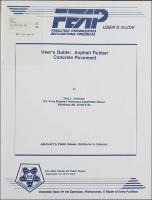Please use this identifier to cite or link to this item:
https://hdl.handle.net/11681/10221| Title: | User's guide : asphalt rubber concrete pavement |
| Authors: | US Army Center for Public Works Facilities Engineering Applications Program (U.S.) Anderton, Gary L. |
| Keywords: | Asphalt concrete Asphalt rubber Gap-graded pavement Open-graded pavement Pavement construction Pavement design Porous friction course Recycling Stone mastic Waste materials |
| Publisher: | Geotechnical Laboratory (U.S.) Engineer Research and Development Center (U.S.) |
| Series/Report no.: | Miscellaneous paper (U.S. Army Engineer Waterways Experiment Station) ; GL-94-50. |
| Description: | Miscellaneous Paper Abstract: Asphalt rubber concrete pavements include at least two types of flexible pavement surfacings made with asphalt rubber cement as the binder, stone mastic and open-graded mixtures. The asphalt rubber binder generally contains 15-25 percent recycled scrap tire rubber blended with standard paving grade asphalt cement. Asphalt rubber concrete pavements are applicable to virtually any flexible pavement surfacing requirement, providing such performance benefits as reduced temperature susceptibility, reduced low-temperature cracking potential, reduced high temperature deformation distress potential, reduced age-hardening potential, and reduced binder-aggregate stripping potential. This report includes discussions of the description, applications, benefits, limitations, costs, and recommended uses for asphalt rubber concrete pavements. A model guide specification for open and gap-graded asphalt rubber concrete pavements is also provided in the appendix of this report. |
| Rights: | Approved for public release; distribution is unlimited. |
| URI: | http://hdl.handle.net/11681/10221 |
| Appears in Collections: | Miscellaneous Paper |
Files in This Item:
| File | Description | Size | Format | |
|---|---|---|---|---|
| MP-GL-94-50.pdf | 6.53 MB | Adobe PDF |  View/Open |